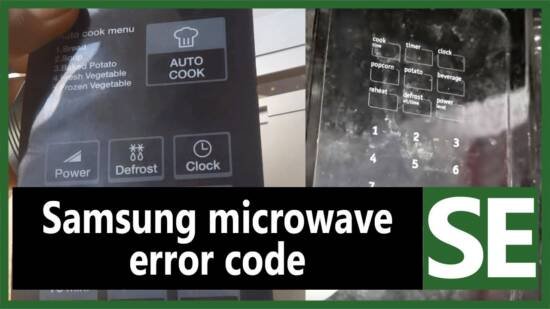
For those of us who aren’t particularly tech-savvy, encountering an error can feel like trying to decipher a foreign language. But fear not! Tackling an LE code is actually simpler than you might think. Essentially, this code usually points to a problem with the microwave’s touchpad or its circuit board. It might sound daunting, but with a little guidance and understanding, you can prevent this error from appearing again in the future. So, let’s dive in and uncover what LE means and, more importantly, how you can stop it from spoiling your dinner plans.
Understanding Error Code LE: What Does It Mean?
So, you’re faced with this cryptic LE code. What’s going on here? To put it simply, this error often signals an issue with the touchpad or control board of your microwave. Consider your microwave’s touchpad as its command center, much like a keyboard is for your computer. When this part doesn’t work properly, commands can’t be processed, and error messages like LE might flash on the display.
The touchpad can stop responding for a variety of reasons. Sometimes, moisture can sneak its way into the delicate circuitry, or daily wear and tear could cause it to misbehave. Think of it like a well-loved book whose pages have become dog-eared over time. The circuit board, which is like your microwave’s brain, can also experience glitches that trigger these error codes. It’s not unusual for electronic components to occasionally go haywire, especially after years of loyal service.
But here’s the thing: understanding the root cause is key. By recognizing what triggers the LE code, you’re already on the path to preventing it. Remember, your microwave is a complex gadget, but it’s not invincible. Just like any other appliance, it needs a bit of care and maintenance to keep running smoothly.
Common Causes of Error Code LE
Let’s get into the nitty-gritty of why the LE error might pop up. You might be wondering, “Why my microwave?” Well, several everyday factors could be the culprit. Moisture is a big one. Imagine cooking up a storm and all the steam has nowhere to go. Your microwave, being enclosed, can trap this moisture, which can then sneak into the touchpad and cause chaos.
Another common reason? Wear and tear. We don’t often think about it, but microwaves work hard. Over time, constant use can lead to degradation of the touchpad. Pushing those buttons multiple times a day eventually wears them down. It’s like a pair of shoes—they’ll eventually show signs of use after countless steps.
Lastly, power surges can also trigger this error. Just like how a thunderstorm can cause your lights to flicker, a sudden spike in electricity can disrupt your microwave’s normal operations, leading to those pesky error codes. So, it’s clear that while these microwaves are technologically advanced, they’re not immune to their environment or intense use.
Steps to Prevent Error Code LE
Alright, so now we know what causes the LE error. But how do we prevent it from haunting your microwave adventures? First, consider this: minimizing moisture exposure can go a long way. Allow your microwave to air out after cooking, especially if you’re heating something heavy on steam. Simply keeping the door open for a few minutes can help displace any lingering moisture.
Next, handle your touchpad with care. It may sound trivial, but being gentle when pressing buttons can prolong the life of your microwave’s control panel. Imagine it like handling your smartphone screen; no one wants their phone to crack, right? This care can prevent wear and tear from taking a toll too quickly.
Lastly, safeguard against power surges with a surge protector. This small device acts like a bodyguard for your microwave, regulating any sudden bursts of electricity before they can do damage. It’s a simple measure that can save you a lot of hassle down the line.
When To Call In The Experts
Believe it or not, there are instances when a professional’s touch might be necessary. If you’ve tried all the preventive measures, but the LE code persists, it might be time to call in the cavalry—an experienced technician. Think of it like visiting a doctor when home remedies just aren’t cutting it.
A trained technician can not only diagnose the issue but also provide a solution that’s effective and long-lasting. They’ll have the tools and know-how to deal with delicate components like the circuit board or touchpad, and if a replacement is needed, they can handle it without a hitch.
While attempting a DIY repair might seem tempting, remember that microwaves are complex pieces of equipment. Mishandling them can lead to more problems, and even safety issues. So, if you’re in doubt, seeking expert help is a smart move. It ensures your microwave gets the best possible care and keeps functioning optimally.
So there you have it—your roadmap to preventing the LE error from rearing its ugly head. With a little understanding of what causes this error and how to prevent it, you’re well-equipped to keep your microwave in tip-top shape. Remember the key steps: minimize moisture, be gentle with the touchpad, and protect your microwave from power surges.
Being proactive with these simple measures can save you time and frustration down the line. And remember, when things get tricky, calling in a professional can turn things around. Your trusty Samsung microwave deserves the best care you can give it, ensuring it’s always ready to give you a helping hand in the kitchen.